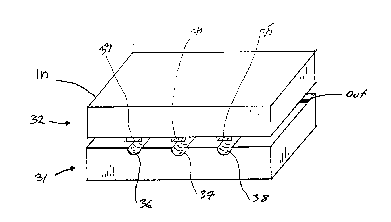Some of the information on this Web page has been provided by external sources. The Government of Canada is not responsible for the accuracy, reliability or currency of the information supplied by external sources. Users wishing to rely upon this information should consult directly with the source of the information. Content provided by external sources is not subject to official languages, privacy and accessibility requirements.
Any discrepancies in the text and image of the Claims and Abstract are due to differing posting times. Text of the Claims and Abstract are posted:
| (12) Patent Application: | (11) CA 2095364 |
|---|---|
| (54) English Title: | RESONATOR STRUCTURE |
| (54) French Title: | RESONATEUR |
| Status: | Deemed Abandoned and Beyond the Period of Reinstatement - Pending Response to Notice of Disregarded Communication |
| (51) International Patent Classification (IPC): |
|
|---|---|
| (72) Inventors : |
|
| (73) Owners : |
|
| (71) Applicants : |
|
| (74) Agent: | MARKS & CLERK |
| (74) Associate agent: | |
| (45) Issued: | |
| (22) Filed Date: | 1993-04-22 |
| (41) Open to Public Inspection: | 1993-11-09 |
| Availability of licence: | N/A |
| Dedicated to the Public: | N/A |
| (25) Language of filing: | English |
| Patent Cooperation Treaty (PCT): | No |
|---|
| (30) Application Priority Data: | ||||||
|---|---|---|---|---|---|---|
|
The present invention relates to a resonator structure com-
posed of two dielectric pieces. On the upper surface of a
first piece (1) is provided a groove (7) extending across
the entire surface and coated with an electrically conduc-
tive agent, said coating being at least in one end con-
nected with an electrically conductive coating serving as a
ground plane, so that the groove (7) forms a transmission
line resonator. On the upper surface of the second piece
(2) is provided a conductive strip (9) running in the mid-
dle of the surface, said strip forming a transmission line
resonator. The pieces (1, 2) are placed with the upper sur-
faces thereof against each other and attached to each other
so that the groove (7) and the strip (9) are against one
another in parallel, whereby the groove and the strip to-
gether form a resonator.
Note: Claims are shown in the official language in which they were submitted.
Note: Descriptions are shown in the official language in which they were submitted.

2024-08-01:As part of the Next Generation Patents (NGP) transition, the Canadian Patents Database (CPD) now contains a more detailed Event History, which replicates the Event Log of our new back-office solution.
Please note that "Inactive:" events refers to events no longer in use in our new back-office solution.
For a clearer understanding of the status of the application/patent presented on this page, the site Disclaimer , as well as the definitions for Patent , Event History , Maintenance Fee and Payment History should be consulted.
| Description | Date |
|---|---|
| Time Limit for Reversal Expired | 1999-04-22 |
| Application Not Reinstated by Deadline | 1999-04-22 |
| Deemed Abandoned - Failure to Respond to Maintenance Fee Notice | 1998-04-22 |
| Application Published (Open to Public Inspection) | 1993-11-09 |
| Abandonment Date | Reason | Reinstatement Date |
|---|---|---|
| 1998-04-22 |
Note: Records showing the ownership history in alphabetical order.
| Current Owners on Record |
|---|
| LK-PRODUCTS OY |
| Past Owners on Record |
|---|
| AIMO TURUNEN |
| HELI JANTUNEN |